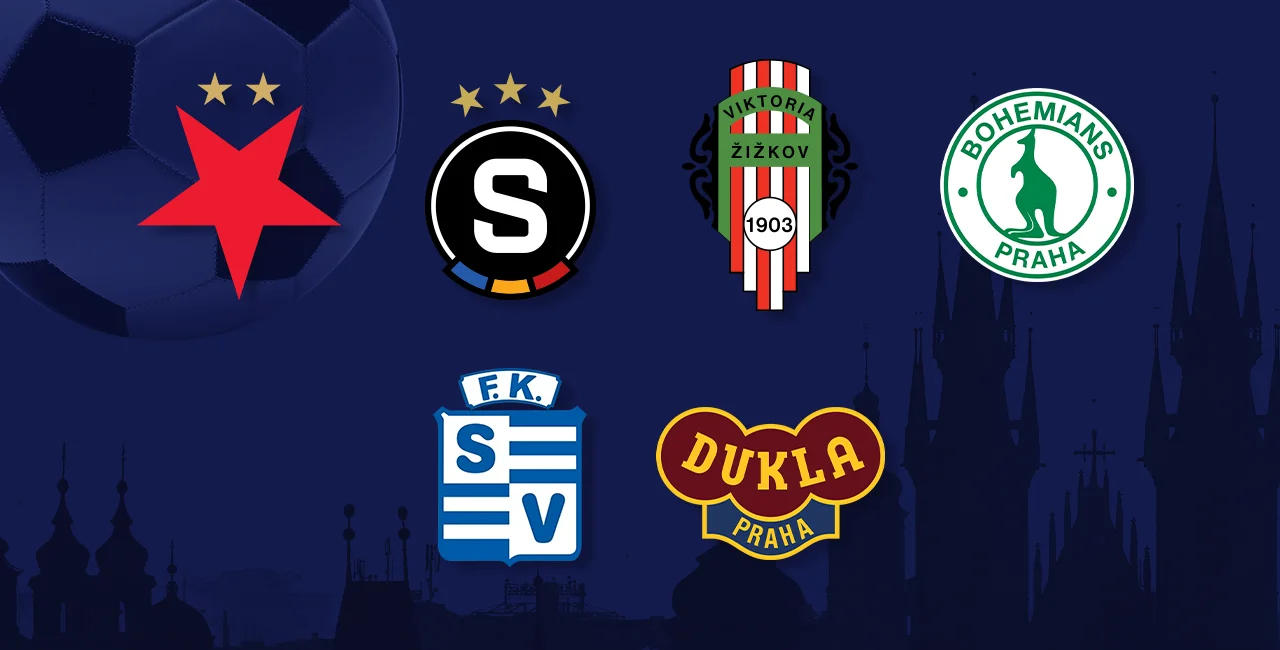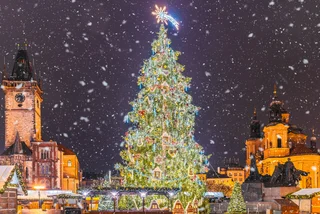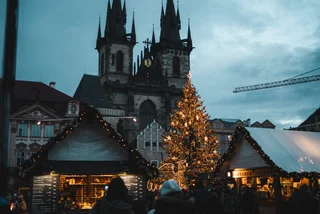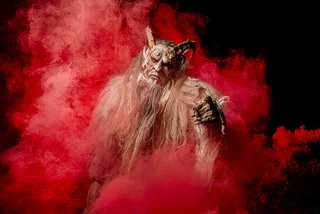The football season in Czechia is underway, and football aficionados – or those simply curious about the phenomenon – will be attending matches and following their preferred team until the culmination of the season in May next year.
But how much do you know about football teams in Prague? You may have heard of the two famous Ss (Sparta and Slavia), and perhaps you noticed Viktoria Žižkov's stadium when passing through Prague 3. Almost all of Prague's six main clubs are over 100 years old and have stood the test of time and historic tribulations – surviving two world wars, the communist regime, and the break-up of Czechoslovakia.
PARTNER ARTICLE
Read our introductory guide to help you learn the basic history and facts of each of Prague's football clubs.
Sparta Prague
Statistics indicate that Letná’s Sparta Prague is Czechia’s most successful club, with the most competitions won. The history of Sparta began in 1891 when several sports enthusiasts founded a sports club called AC Prague in the capital's Maniny area in present-day Prague 7, later named the Athletic Club of Královské Vinohrady.
Behind the name and colors
In 1893, the new Athletic Club Prague was officially formed, and soon after the club adopted its colors of blue, red, and yellow. Blue symbolizes Europe, and red and yellow are the colors of the Royal City of Prague. In 1894, the club adopted the name “Athletic Club Sparta Prague,” in reference to the ancient Greek city of Sparta, whose inhabitants stood out for their fighting spirit and mettle.
Initially, Sparta players wore black shirts with the letter "S" embroidered on their chest. They then used a black-and-white striped shirt combination for two years in the early 20th century. In 1906, one of the members of the team’s committee visited England and brought with him jerseys belonging to the London club Arsenal FC. Inspired by the kit, from that time Sparta has typically played in red, dark red, or maroon colors.
Czech giant Sparta Prague have unveiled their new crest. A modernization I strongly support since it keeps with tradition. The legendary S still stands proud along with the iconic tricolor. Black is the new black.#logodesign #LogoDesigns #badge #logo #logos #footballdesign pic.twitter.com/GNKUXeqkku
— World Football Club Crests (@WorldClubCrests) February 11, 2021
The club plays in Letná, at the epet ARENA, with a capacity of 19,416. The club has played at the same stadium since 1917, but is set to move away in the coming years in order to increase total attendance. No timeframe for this move has been set.
The club is known as Železná Sparta (Iron Sparta), Rudí (The Reds/The Maroons), and Letenští (meaning those from Letná).
Czechia's most-decorated club
Sparta is the current holder of the Czech First League title (the highest division in current Czech football); its 2022/23 title victory was the first since 2013/14. Since 1993 – Czechia’s Velvet Divorce– it has won the highest amount of Czech First League titles in the country (13). Its last victory in the domestic Czech Cup knockout competition was in 2020, and it is the country’s most successful team in this tournament, with eight wins since 1993. Overall, Sparta has won 37 domestic league titles and 15 Czech Cups – both are records.
A strong European display in the past
Sparta’s best achievement in current European competitions was reaching the semifinals of the 1991/92 European Cup. It is the three-time winner of the Central European Cup (winning the title in 1927, 1935, and 1964). In 1973, the club made the semi-finals of the UEFA Cup Winners' Cup (a continental competition for clubs that won domestic trophies). Just a couple of years later, however, the club was relegated to the second tier for the first (and only) time in its history.
Sparta also won the UEFA Intertoto Cup – a summer European competition – three times. The club had been a regular participant in the group stages of the UEFA Champions League, Europe’s most prestigious club competition, in the first half of the 2000s. Recent years have seen Sparta struggle in the competition, with the club failing to make the preliminary (qualifying) stages.
In Europe’s second-tier club competition, the Europa League (previously known as the UEFA Cup), Sparta’s best recent result has been finishing second in its group in the 2012/13 Europa League. The Czech club was narrowly defeated by English club Chelsea FC in the round of 16 match.
The most hotly anticipated matches every season are with long-time nemesis Slavia Prague. Since 1896, the Prague teams have played each other 307 times, with Sparta leading the head-to-head by 137 wins to 97 (with 72 draws between both).
Reigning champions, but second-best in past decade
Before winning last season’s championship, Sparta experienced a relatively disappointing decade, finishing outside the top two on five occasions – even coming in a lowly fifth in the 2017/18 season. Its most dominant streak in recent domestic football was between 1984 and 2001, when it won 15 out of a possible 19 domestic league titles.
A Ballon d'Or winner and billionaire chairman
Notable football players include midfielder Pavel Nedvěd, who won a Ballon d'Or (the most prestigious individual prize in men’s football) in 2003, Jan Koller, the all-time top scorer for the Czech Republic national team, and Tomáš Rosický, who enjoyed successful and lengthy spells at European giants Arsenal and Borussia Dortmund. Famous English Premier League goalkeeper Petr Čech also spent a season at Sparta early in his career.
The club’s chairman and majority owner is one of the richest men in Czechia, Daniel Křetínský. The head coach for the 2022/23 season is Dane Brian Priske.

Slavia Prague
Sparta’s arch-rivals, Vršovice-based Slavia Prague has for over 100 years jostled with its northern neighbors in the attempt to be Czechia’s best club.
The club was borne out of the Academic Cycling Club of Slavia that had been established in 1892 by a patriotic, pro-Czech university association (interestingly, it was dissolved by authorities for alleged anti-Austrian activities). In 1895, football became an official sport within the newly founded Slavia Sports Club.
Slavic pride and hope in times of failure
The name “Slavia” pertains to pan-Slavism and was chosen to show the club’s pride to be Slavic. The club plays in red and white – reflecting the national flag of the time – and has the same colors displayed on its crest.
According to the club, the color white symbolizes the purity of sporting thought and fair play, and red shows the heart that the team puts into its matches. The current crest shows a five-pointed star pointing downwards – designed to symbolize hope even in times of failure.
A new crest introduced in 2022 features two smaller stars above the main red one. These represent the club’s historical achievements (one star represents 10 domestic league titles won).

The club is nicknamed the red-and-whites and “the stitched” – a term that originates from the fact that Slavia’s old football shirts were made of two parts sewn together.
In total, Slavia has won 21 league titles from the pre-1993 Czechoslovak and modern Czech leagues. It has also won the domestic Czech Cup 11 times; the second-most out of all clubs. It has also won the Pearl Cup, Czechia’s oldest knockout competition and predominantly played by lower-league teams, five times – twice more than Sparta.
Slavia has since 1953 played at the Fortuna (informally known as Eden) Arena, which holds 19,370 people. Before this, they were based in Letná until Nazi soldiers burnt it down.

British influence and difficulty under communism
Interestingly, Slavia has a notable British connection. In 1905, Scottish John Madden became the team’s coach – a role he kept for 25 years. During this period, Slavia ranked among the best teams in continental Europe and won multiple domestic competitions, such as the pre-war Czech Football Association and the Central Bohemian Cup.
The 1930s are known as Slavia’s “glory years,” during which time Slavia won the Central European Cup and five Czechoslovak Football League titles.
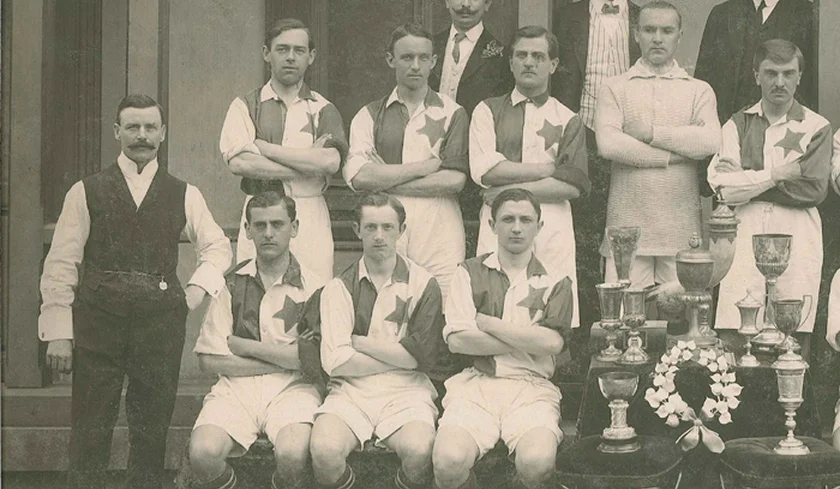
Slavia struggled in the 1950s – the communist regime even forced Slavia to change its kit from the traditional red and white to a mix of blue, white, and yellow for around five years. The club was seen by many as a bourgeois, and the authorities had wished for its demise.
The word "Slavia" also did not appear in the club's name between 1953 and 1964, when it was renamed Dynamo Prague.
Struggles before takeover
Following financial struggles and high debts in the first half of the 2010s that resulted in weak performances, new state-owned Chinese ownership changed Slavia’s fortunes in 2015. It won the Czech First League in the 2016/17 season and then won three consecutive league titles between 2019 and 2021. Slavia finished second last season. It also won the Czech Football Cup four times between 2018 and 2023. Prior to 2015, the club had finished a lowly 13th position in 2014 and came 12th in 2012.
European achievements
Slavia’s best performance in Europe is reaching the semi-finals of the UEFA CUP (now known as the Europa League, the second-tier club competition across Europe) in the 1995/96 season. In recent years the club has impressed in the competition, reaching the quarter-finals in 2018/19 and 2020/21 (losing to Chelsea FC and Arsenal respectively).
In the Champions League, Europe’s most prestigious club competition, Slavia qualified for the group stages in 2019/20 and impressively held Spanish football giants FC Barcelona to a draw at the Catalan club’s stadium. Further back, in the 2006/07 season Slavia finished third in its group, holding Arsenal to a draw in Prague.
Slavia is Czechia’s most successful club in the (now-defunct) Intertoto Cup, winning the European competition a total of seven times.
A Champions League winner and ex-government minister
Famous players include Josef Bican, who in the 1930s and 1940s scored 1,131 goals in 514 appearances, Vlastimil Kopecký, who played 953 first-team matches between 1932 and 1950, and – more recently – Vladimir Šmicer, who was one of the runners-up of the 1996 European Football Championship and went on to win the Champions League with Liverpool in 2005.
The club’s current chairman is former Minister of Defense (2001-03) Jaroslav Tvrdík, who had been part of Former Prime Minister Miloš Zeman’s cabinet. Jindřich Trpišovský is Slavia’s coach for the 2023/24 season.
Adult tickets to the Fortuna Arena for league games start from CZK 260 and can be purchased on the official website.
FK Viktoria Žižkov
Representing Prague 3’s Žižkov district, FK Viktoria Žižkov is one of Czechia’s oldest clubs that saw its greatest success before World War II.
Olden glory days
Founded in 1903 by students from the town of Žižkov (which, back then, was not part of Prague), the club currently plays in Czech National Football League (the second tier of Czechia’s football system) after being crowned champions of the Czech Football League (the third tier) last season.
It was originally called SK Viktoria and was one of the best clubs in the country in the 1920s. Viktoria Žižkov’s 5,600-capacity stadium is based on Seifertova Street (opposite the eponymous tram stop) and has been in use since the 1960s. “Viktorka” is the nickname for the club.
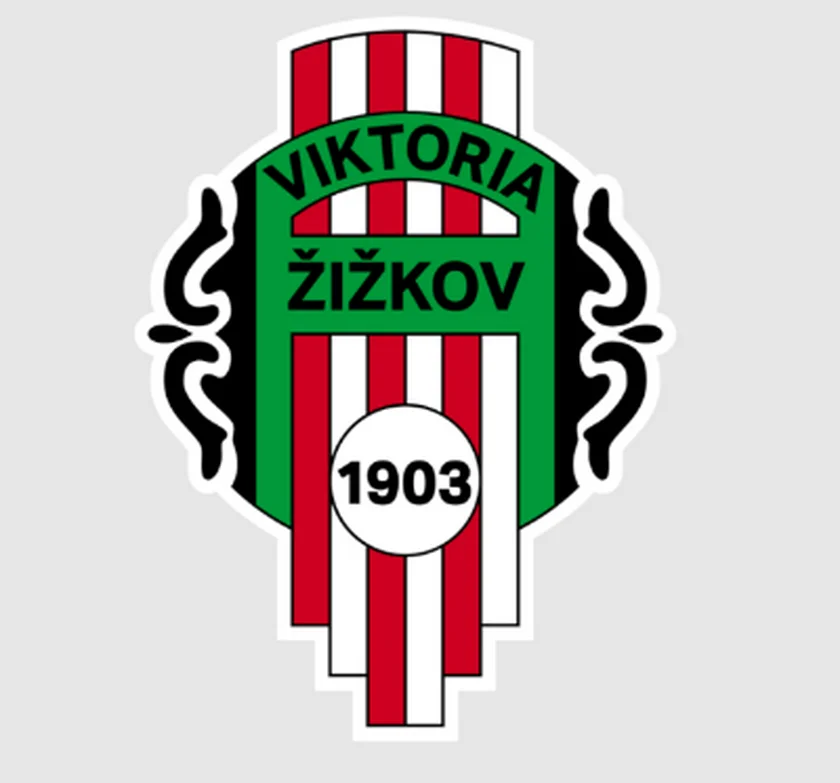
The club’s best period came in the 1920s. It won the Czechoslovak Football League (then the highest level of Czechoslovak football) in the 1927/28 season and came second in the following year. Its best performance in European competitions also came in the 1920s, when Viktoria reached the semi-finals of the inter- and post-war Central European Cup.
The club colors are red, white, and black – these were chosen to reflect the historic flag of Bohemia. The team’s home shirt consists of red-and-white vertical stripes.
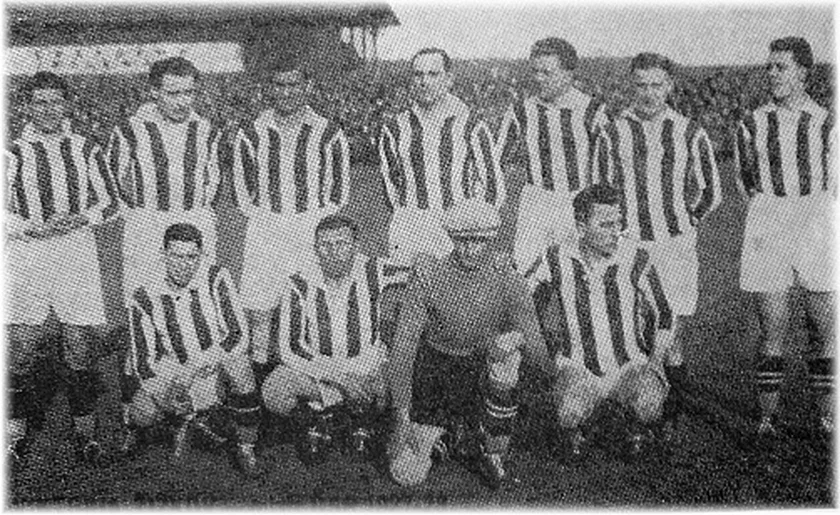
Communism hitting Viktoria
The club struggled in the early 1950s, when the communist regime decided to link sports units with industrial enterprises. Being a residential area, Viktoria Žižkov was unable to find a suitable and close partner. This caused Viktoria to drop to the lowest divisions of Czech football, during which time the club’s name changed to Slavoj Žižkov.
In 1959, the club climbed its way back into the second division, and six years later changed its name back to Viktoria Žižkov.
Some success since the 1990s
More recently, the club’s best successes have been coming third in the first-tier Czech Football League (in 2002 and 2003) and winning the Czech Football Cup in 1994 and 2001 (beating Sparta Prague in the final in this year).
Notably, in the 2002/03 UEFA Cup, it knocked out the famous Scottish club Glasgow Rangers. It also won the Pearl Cup – Czechia’s oldest knockout competition and predominantly played by lower-league teams – in 2009.
Corruption and unpaid wages
The club has typically yo-yoed between the first and second tiers of Czech football. A corruption scandal in 2004 involving bribery by former manager Ivan Horník saw Žižkov lose 12 points in the 2004/2005 season after being relegated from the first tier the year before.
During the 2014/15 season, Viktoria faced a culmination of long-standing debts, leading to a temporary player boycott due to unpaid wages. The Prague 3 district town hall – owed CZK 900,000 for stadium rent – requested debt repayments, increasing the risk of Žižkov’s stadium being repossessed. Despite all the financial chaos, the club achieved a fourth-place finish that season, narrowly missing promotion to the top league.
However, during the summer of 2015, the club lost its license to play in Czechia’s second division and was relegated to the third. However, it spent just one season in the third tier, before being promoted for the 2016/17 season. Since then, it has remained in the Czech National Football League with the exception of the 2022/23 season.
Well-known players and in popular culture
The team’s current coach is Michal Hornák, who played in the Czech team that finished runners-up in the 1996 UEFA European Football Championship. One of the club’s best-known players from the past is midfielder Karel Poborský, who also featured in the 1996 final and went on to play for both Slavia and Sparta Prague.
FK Viktoria Zizkov stadium. pic.twitter.com/y3zpDWD2QX
— Rico (@ThatBoiRico) November 6, 2015
Famous Czechoslovak film actor Vlasta Burian was the regular goalkeeper for Žižkov around 1916 before focusing on his acting career. The popular Czech 1931 comedy film Muži v offsidu (Men Offside) is based mainly on the culture and fans of Viktoria Žižkov, and features footage of several matches from that time.
Tickets at the Viktoria Žižkov stadium start from CZK 120 and can be bought via the club’s official ticket-selling site here.
Bohemians Prague 1905
Just down the road from Slavia’s stadium is another club over a century old, which happens to have a kangaroo on its crest – Bohemians Prague 1905. The club started out as SK Kotva back in 1895 when it was formed by a small group of cycling and football enthusiasts. Ten years later, it became known as AFK Vršovice.
An Australian connection
But why does the club today have an English-sounding name? After all, “Bohemians” translated into Czech is “Bohémů.”
The answer lies in a landmark 1927 trip to Australia. After an invitation from the Australian state to visit was made to Slavia Prague and Viktoria Žižkov – and duly declined – AFK Vršovice took up the offer and went on their Australian tour. The club realized that Vršovice would most likely be unpronounceable for Australians and so they decided to adopt a new name – AFK Bohemians.
Shortly afterward, the kangaroo – on Australia’s coat of arms – featured on the club’s crest and became the club’s mascot. In fact, the footballers brought with them a pair of kangaroos when they returned to Czechia, which were then presented to then-President Tomáš Garrigue Masaryk. The main nickname of the club today is the “Kangaroos.” The club colors are green and white.
The club plays at the 6,300-capacity Ďolicek Stadium and has been doing so since 1932. It was originally called Danner’s stadium, named after former club chairman Zdeňko Danner, who also played a significant role in the club’s creation. Between 2010 and 2012, the club’s board decided to play all home matches at Slavia Prague’s stadium. Poor ticket sales and fan dissatisfaction saw this decision reversed, however.
#FloodlightFriday ÄŽolÃÄek, home of Bohemians Praha 1905. A Kangaroo on the club badge is from a tour to Australia in 1927 when they changed their name from AFK VrÅ¡ovice to save confusion and mispronunciation. The party were given 2 marsupials to take back to live in Prague Zoo. pic.twitter.com/qfIWkXqAb1
— Rob Bernard (@Rob_Bernard) June 16, 2023
The golden 1980s
The club’s most successful period came in the early 1980s, when it won the Czechoslovak Football League in the 1982/83 season and finished runners-up one year later. It also won the Czech Football Cup in 1982, and one year later made the semi-finals of the UEFA Cup. This season, it reached the preliminary stages of the new UEFA Conference League, marking the club’s first European competitive match since 1988.
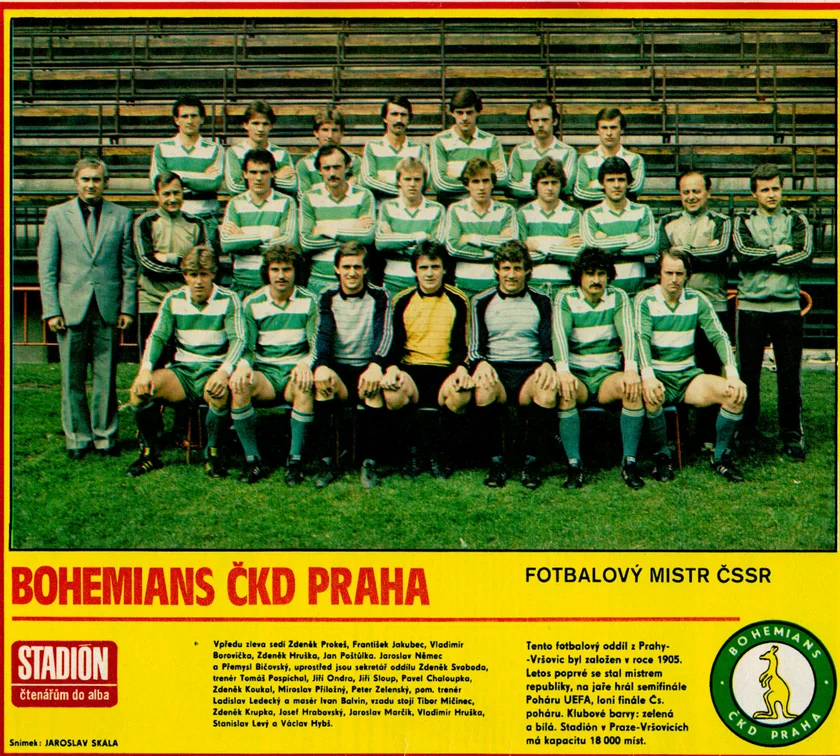
Bohemians also performed particularly well in the Intertoto Cup, winning the competition five times between 1979 and 1984. It also won the Pearl Cup five times, most recently in 2013.
Name-change drama
In the past 30 years, the club has yo-yoed between the first and second tiers of Czech football. Crisis came in 2005, however, during a complicated and protracted legal battle about the name and badge of Bohemians 1905.
Then known as FC Bohemians Prague, in 2005 the club was relegated to the third division following severe financial issues, and its name and logo were leased to – and used by – a different club, FK Střížkov Prague 9. This forced FC Bohemians Prague to change its name to Bohemians 1905, and huge animosity between the two sides followed for years. The Bohemians Fans’ Association stayed loyal to the original, century-old club, and raised CZK 3.8 million in a fundraiser to stay afloat.
In September 2012, a Czech court ruled that the former Střížkov club could not use the name “Bohemians” after January 2013 – three years later, the Střížkov team was dissolved. Since 2013 the club has officially been named as Bohemians Prague 1905 and has played in the top tier of Czech league football.
The chairman of the club is famous retired midfielder Antonín Panenka, who scored the winning penalty in Czechia’s 1976 European Football Championship final against West Germany. Jaroslav Veselý has been first team coach since 2022.
Tickets for home matches start at CZK 200 (CZK 250 on matchdays) and can be bought on the official site. Terraced (standing-only) sections are available.
FK Dukla Prague
This Dejvice-based club saw its best success in the 1960s, when it had been the best team in Czechoslovakia for much of the decade.
The 1960s: A prosperous period
The club was founded in 1948 on the grounds of the Czechoslovak Army and was originally called ATK Prague (the Army Sports Club). Within 10 years, the club won its first two Czechoslovak Football League titles (in 1956 and 1958), and then went on to win five league championships between 1961 and 1966.
The 1960s also saw great success in the Czechoslovak Football Cup, when it won four championships. Dukla also performed strongly in this competition during the first half of the 1980s, when it was crowned champions three times.
The club plays its home matches at the Juliska stadium in Prague 6, which belongs to the Czech army and has a capacity of around 8,150. The club colors are red and yellow.
In total, Dukla won the Czechoslovak Football League 11 times and won the Czechoslovak Cup nine times – its success in the domestic cup competition is the best out of any Czech team between 1950 and 1993.
In European competitions, Dukla performed best in the 1960s and 1980s. It reached the quarter-finals of the European Cup (today’s Champions League equivalent) three consecutive times, and made it to the semi-finals in 1967 – its best-ever performance. In 1986, Dukla was knocked out of the semi-finals of the European Cup Winners' Cup by eventual champions Dynamo Kyiv.
Struggles after the end of communism
After the break-up of Czechoslovakia, the club struggled. Sparta Prague, Dulka’s main rivals, obtained large commercial sponsorship contracts that ensured much higher success than Dukla in the 1990s. Dukla’s reputation of being a pro-army team during the communist regime also dented prospects for possible sponsorship deals.
1998-99 FC Dukla Pribram Umbro Home Shirt *Mint* XLhttps://t.co/BnX5GhFQ2B pic.twitter.com/HWNtHzeH0B
— The Football Shirt Finder (@FinderShirt) September 10, 2021
Following continued struggles and a fall to the third tier of Czech football in the mid-1990s, Dukla in 1996 merged with Central Bohemian side then known as FC Portal Příbram to become FK Dukla (and FK Dukla Příbram thereafter). The newly merged club was promoted soon after and played its way back into the Czech First League. FK Dukla Příbram won the Pearl Cup in 1999 and 2000, and at the turn of the millennium was renamed FC Marila Příbram.
A breakaway and a new merger
Many, however, were not happy with the merger and Příbram being credited with Dukla’s past successes. In 1998, a section of FK Dukla Příbram founded a new club altogether – FK Dukla Prague – and separated from Příbram. After three years in the wilderness, the club merged with lower-league FK Dukla Dejvice.
19/10/22
— The Football Politician (@catenaccio_Gi) October 21, 2022
FT: Dukla Praha 0 Vs 4 Slavia Praha
A historic derby, Dukla founded in 1948 after military liberated the country of Nazi regime and went onto dominate Czech football during communist era
Slavia, persecuted under communist regime
A classic Under the floodlights pic.twitter.com/89Vvi7DA27
Between 2001 and 2007 it played in local Prague leagues and the fifth tier of Czech football, before eventually being promoted to Czechia’s second division in 2007. In the 2010/11 season, it gained promotion to the Czech First League after winning the second-division championship.
Match-fixing issues
It remained in the top tier for much of the 2010s, but a 2018 match-fixing scandal that saw Dukla’s executive director try to influence matches by cooperating with the then-vice-chairman of the Czech Football Association tarnished the club’s reputation. The club was fined CZK 400,000, and since 2019 has been in Czechia’s second tier.
Another Ballon d'Or winner
Famous past players include Josef Masopust, who won a Ballon d'Or in 1962 and in 2000 was voted the “Czech Football Personality of the Century.” Midfielder Nedvěd also played for the Prague 6 outfit for two years, as did goalkeeper Ivo Vicktor for almost 15 years (1963-1977), who was regarded as one of the best goalkeepers of his generation in Europe during his prime.
Petr Rada, who played for the Czechoslovak national team, has been coach since last year. Interestingly, Rada coached Sparta Prague in 2017, and Slavia between 2012 and 2013.
Tickets for home games at Juliska start from CZK 180 for adults (when bought online). A discount of CZK 50 applies to residents of Prague 6 and students. More information can be found on the official website.
Slavoj Vyšehrad
This Prague 2 club is one of Prague’s smallest, although is 40 years older than FK Dukla Prague. Its stadium has a capacity of just 2,500 spectators.
Confined to the lower leagues
Founded in 1907 in Prague’s Vyšehrad region, it has historically played between the third and fourth tiers of Czech football. It reached its highest point in Czech football in the 2015/16 season, when it competed in the National League (the second tier). After being relegated, it once again became a second-division team in the 2019/20 season.
Slavoj became known to the wider public in 2016 after the launch of an internet comedy series named Vyšehrad, the plot of which is set in the environment of the club itself.
A proper inner city ground, completely hemmed in by houses. Like it.
— Michael Petersen (@micpetersen) August 12, 2022
Slavoj, reeling from corruption scandal and demotion, put in a good shift against the more fancied visitors who equalised late.
Prazsky Prebor (level 5)
Slavoj Vyšehrad v Dukla JM 4-4, att 106#groundhopping pic.twitter.com/VxKTD4F2GP
Downfall after corruption scandal
In the year 2020, the club was embroiled in a corruption scandal featuring its former sports manager, Roman Rogoz. He was found to have exerted unfair influence over match outcomes by colluding with referees and allegedly resorting to bribing both referees and players, offering tens of thousands of crowns for favorable decisions.
🟠FK Slavoj Vyšehrad 🇨🇿#TicketBoxTuesday pic.twitter.com/XsVvBXLNqv
— âš’Jo van der Heijdenâš’ (@WHUFC_Helmond) December 7, 2021
The scandal was brought to light in October 2020 when law enforcement intervened. Consequently, the club suffered severe damage to its reputation and was swiftly demoted from the second to third Czech tier of league football. After this, the Czech Football Association’s Ethics Commission decided to remove Slavoj from the third division. It currently competes in the regional Prague Championship (the fifth tier of Czech football).
The team’s colors are blue and white (also the color of the home kit). Tickets can only be purchased at the stadium and not online. Prices start from CZK 100.












 Reading time: 17 minutes
Reading time: 17 minutes 